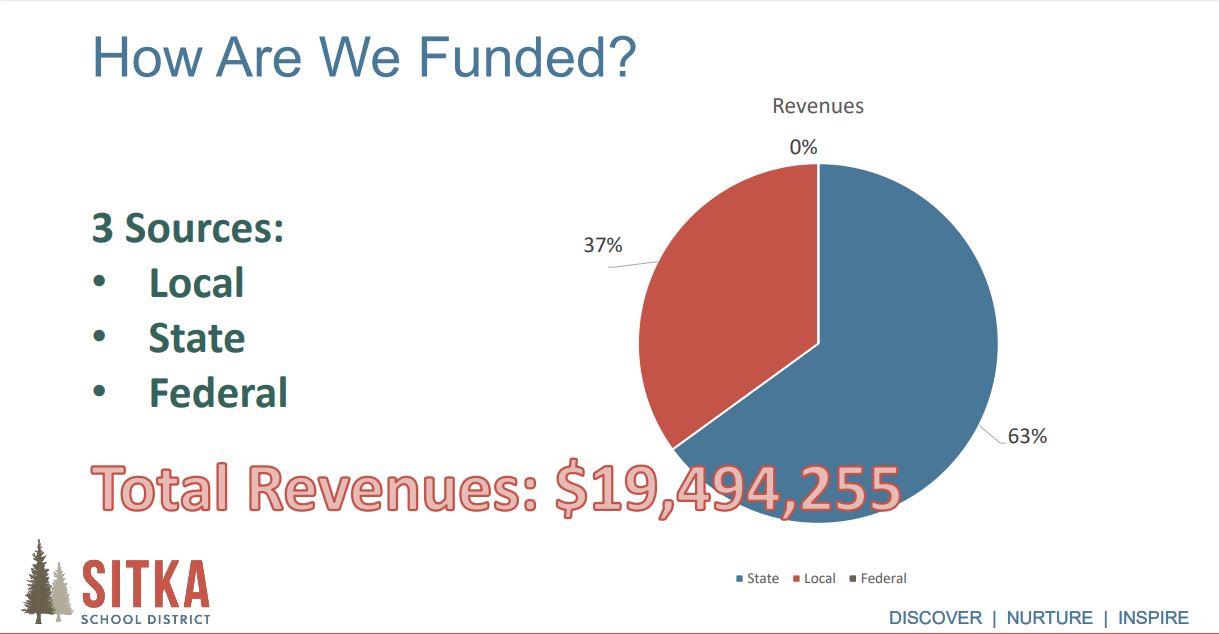
The Sitka School District is within $700,000 of having a balanced budget for the next school year — a significant contrast from the budgeting picture this time last year. A member of the public referred to it as “the nicest deficit we’ve had in several years.”
Note: The next school board budget hearing is scheduled for 6 P.M. Friday, March 27 in the Sitka High School Library. Here is information from the February 19 presentation.
In 2019, Alaska Gov. Mike Dunleavy proposed cutting funding for public education by 25-percent, which would have meant a loss of around 45 positions in the Sitka Schools in the current school year.
The state legislature pushed back, and the governor subsequently relented — but not until a campaign to recall him from office collected signatures at a record pace.
With no imminent crisis or threat this year, the first public budget hearing of the Sitka School Board was lightly attended last week (2-19-20), and — compared to the recent past — the projected deficit for next year seems manageable: only $684,000.
The reauthorization of the federal Secure Rural Schools funding is one reason the district’s numbers are better balanced looking ahead to next year; another is the Sitka Assembly’s recent decision to fund local schools to the maximum allowed by state law.
The municipality of Sitka contributes 37-percent of the district’s $20 million budget. School board president Elias Erickson said having the city’s full backing at this stage of budgeting process was significant.
“37-percent of our revenues we can be certain of at this point in the process,” said Erickson, “which is much more helpful than where we were last year at this point in the process, not knowing where 100-percent of our revenues were going to land.”
The other 63-percent of the district’s funding comes from the state — specifically the Alaska Legislature — which historically has never cut funding to schools. Most likely, state funding will remain the same as last year. Flat funding, plus slight increases in costs like salaries, utilities, and insurance, has created the $700,000 gap for the Sitka district next year.
Career and Technical Education teacher Tim Pike was one of only three people who attended the budget hearing. He suggested that audiences would be larger if people better understood what programs or facilities were on the line.
“And so I’ve witnessed you in the last couple of years turn your March work session into a hearing-then-a-work-session,” Pike said. “And I’d encourage you to do the same again. Because at that point a lot more clarity will be available to people. And a presentation about where you’re headed could then elicit more response from the community, because at this point in time we have nothing to work with.”
The other two members of the public present were also teachers. Elementary music teacher Susan Brant-Ferguson advocated for restoring a full-time counseling position at Blatchley Middle School.
“Probably part of the reason that’s not filled is that it’s a half-time counselor, half-time P.E. which is not a position that most professionals would be aiming toward,” said Brant-Ferguson. “And I think that it’s an essential position to every level of our school, and it needs to be budgeted for as a full-time counseling position.”
Brant-Ferguson said she knew it was a difficult ask in light of the budget deficit, but she said this was “the nicest deficit we’ve had in several years.”
Mike Vieira, also a shop teacher, agreed with the need for a full-time counselor at Blatchley. The district had contracted, down seven teachers since 2018, and he thought it was time to rebalance positions. He also had concerns about the high school building, which still feels new to many people, but is actually starting to show signs of age.
“We think about this building as being brand new because it’s such a nice building that got remodeled, but we’re 20 years into the remodel,” said Vieira. “And if you start walking down the hallways and looking at the carpet, it’s starting to fade. And there’s a spot down here where the floor’s starting to slope. And I guess my question is: How long do we expect the carpet to last?”
Vieira had similar worries about tile in bathrooms and locker rooms. A member of the teachers union, Vieira said it felt strange to be advocating for building maintenance instead of teachers, “but at some point we have to think about keeping this place up.”
The school board took no official action at the hearing. The members agreed that the next hearing and meeting in March should include some specific options for closing the $700,000 budget gap for next year.






























